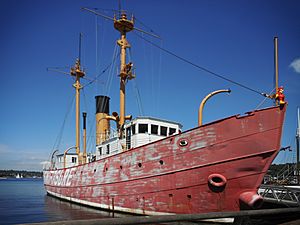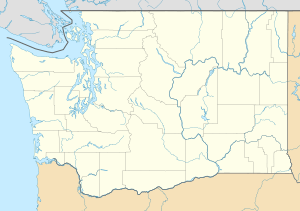United States lightship Swiftsure (LV-83) facts for kids
Light Vessel Number 83 (LV-83), also known as Swiftsure, is a special kind of ship called a lightship. These ships act like floating lighthouses. Today, LV-83 is a museum ship owned by Northwest Seaport in Seattle, Washington.
This historic ship was built in 1904 in Camden, New Jersey. It served actively until 1960, guiding other ships along all five of the American west coast's lightship stations. It is the oldest lightship still floating in the United States. It's also the only one that still has its original steam engine and the last one with wooden decks. Because of its importance, LV-83 was named a National Historic Landmark in 1989. It has been undergoing a big restoration project since 2008.
Contents
What is Lightship LV-83 Swiftsure Like?
Ship Design and Size
When it was first built, LV-83 was one of the newest lightships of its time. It had a strong steel hull and wooden decks. It also featured a powerful steam engine. The ship measured about 112 feet (34 meters) long at its keel and 133 feet (40.5 meters) overall. It was about 28 feet 6 inches (8.69 meters) wide and sat 12 feet 6 inches (3.81 meters) deep in the water. The ship weighed 668 tons when empty. Later, a part at the front of the ship was removed, making its total length 129 feet 6 inches (39.47 meters).
Today, the ship has several important tools to help with navigation. It has a bright 1,000-watt beacon light. There's also a very loud 140-decibel Diaphone horn and a 1,000-pound (450 kg) fog bell on the front deck.
When the ship was new, its main light was a set of three oil lamps. These lamps could be lifted up the masts from the deck. They first used whale oil, then kerosene, and finally became electric in 1930. The main sound signal was a 12-inch (30 cm) steam whistle. The large 1,000-pound bell was used as a backup. For a while, LV-83 also had an underwater bell. This bell would strike out the ship's identity as a submarine signal. Sound travels much farther in water, which helped ships hear its signals from a greater distance. The underwater bell was removed when a radio beacon was added for long-range signaling.
How the Ship Moved
LV-83 was powered by a single 8-foot (2.4-meter) wide propeller. This propeller was driven by a 375-horsepower marine steam engine. Originally, the engine got its power from two coal-fired boilers. The ship had two coal storage areas, each holding 75 tons of coal. It also carried over 11,000 gallons (41,600 liters) of fresh water. In 1934, the old boilers were replaced with modern oil-fired boilers. This change made the ship able to travel longer distances. It also made fueling faster and allowed the ship to get ready to move more quickly. Plus, it meant fewer crew members were needed in the boiler room.
The Ship's Crew
During its active service, LV-83 usually had a crew of 15 people. Ten of them would be on duty at any time, while the others were on shore leave. The crew size changed a bit over time. For example, when new technology like oil-fired boilers or electronic devices like radio and radar were added, fewer people were sometimes needed. During World War II, the ship's crew grew to more than 30. This was because extra guns were added for wartime duties, and more people were needed to operate them.
The History of Lightship LV-83 Swiftsure
Early Years and First Assignment
LV-83 was launched in Camden, New Jersey in 1904. It was then sent to the West Coast to work at the Blunt's Reef lightship station. At that time, the Panama Canal was not yet finished. So, LV-83, along with another lightship (LV-76), had to sail all the way around the tip of South America. Then they traveled north to San Francisco. Its first station was at Blunts Reef off Crescent City, California. While there, the ship performed a heroic rescue. It saved 150 people from the steamer Bear after that ship ran aground on the reef in thick fog.
Changing Names and Stations
LV-83 was once known as Relief. Over its years of service, it had many different names painted on its sides. Each name showed the location of the station where it was serving. For example, Swiftsure refers to the Swiftsure Bank. This bank is near the entrance to the Strait of Juan de Fuca, which separates Washington from Vancouver Island. The ship also helped guide other vessels near Umatilla Reef and the Columbia River Bar.
Retirement and Preservation
The ship was taken out of service in 1960. In 1966, it was bought by Northwest Seaport, a non-profit organization dedicated to preserving maritime history. LV-83 is now listed on the National Register of Historic Places. It was also declared a National Historic Landmark in 1989 and is on the Washington State Heritage Register.
Today, LV-83 is docked on Lake Union in Seattle, Washington. A long-term restoration project began in 2008 to bring the ship back to its former glory. Visitors can usually explore LV-83 on most summer weekends, or by making an appointment.
See also



